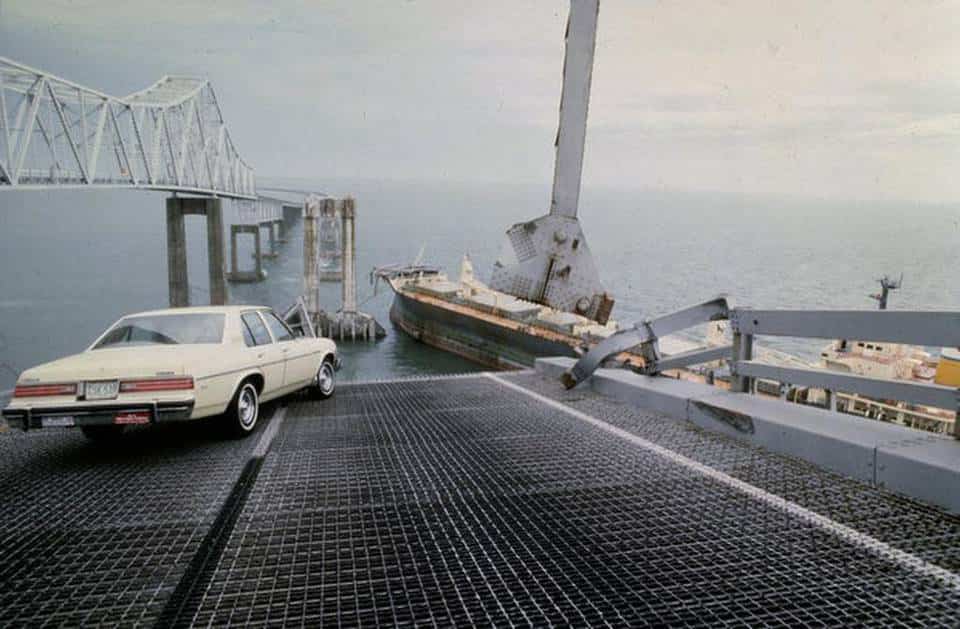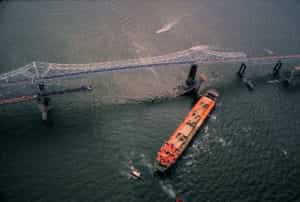Know
The Skyway Bridge tragedy: ‘The elements had control of that vessel’

This series was first published in the Catalyst in 2020.
The latest advisory from the National Weather Service was several hours old when the freighter MV Summit Venture knocked down the west span of the Sunshine Skyway Bridge at 7:34 in the morning on May 9, 1980:
Small craft should exercise caution. Winds southerly increasing to 10 to 15 knots this morning. Seas increasing 4 to 6 feet today then diminishing tonight. Winds and seas higher near scattered thunderstorms today.
It wasn’t supposed to be there. Yet there it was, a squall of such intensity that visibility on Tampa Bay was reduced to practically zero, the wind in gusts of up to 70-75 miles per hour, hurricane force, a solid wall of blinding rain blown horizontally against the ship’s wheelhouse windows, swirling and angry and changing direction in an instant.
The storm was so sudden that John Lerro, the harbor pilot at the wheel of Summit Venture, had little to no time to prepare, and so violent that neither he, his co-pilot in training nor the all-Chinese crew had any inkling that the vessel, riding relatively light even at 20,000 tons, was being pushed south, out of the shipping channel, in erratic increments.
Eastbound from the Gulf of Mexico, Summit Venture needed to stay in the channel to safely pass under the two identical bridge spans, which were rendered invisible to the naked eye and on the ship’s radar screen, completely occluded by the deluge from the skies.
At 606 feet in length, Summit Venture would need nearly a mile to come to a complete stop, even if the pilot ordered the engine killed or thrown into reverse. Ships don’t have brakes. Dropping the anchors wouldn’t stop it. And at 7:23, the precise moment that Summit Venture was ambushed, it was already less than a mile from the side-by-side spans of the Sunshine Skyway Bridge.
Forty-one years have passed since that dark, wet spring morning when Tampa Bay lost its innocence.
The magnitude of the tragedy took nearly a week to reveal itself, as bodies continued to wash up, unexpectedly, on nearby beaches and in leafy tangles of mangrove.
Just under 1,300 feet of over-water roadway fell when Summit Venture sheared off a support pier 54 feet above the waterline. This included more than half of the apex of the southbound Skyway, the southern slope, 150 feet over the water.
Tall enough to allow large oceangoing ships to pass through, to and from the deepwater port in Tampa – where Summit Venture was bound – and the smaller facility in Manatee County.
Tall enough so that eight cars and a passenger bus sailed off the break and struck the water in less than four seconds, and were practically destroyed on impact.
Thirty-five people died; 26 of them were on the bus, the last vehicle to plunge off the bridge. Many of them were headed for family reunions in South Florida on that Mother’s Day weekend.
Aboard Summit Venture, no one felt a shake or a shudder. The starboard bow had literally scraped alongside a secondary bridge support. Damage to the ship’s bow was minimal.
But the Skyway was built to withstand the weight of great vertical loads, from vehicular traffic, not a horizontal hit from 20,000 tons of steel.
The northbound span, less than 75 feet to the east, was untouched.
Listen to the first two minutes of Lerro’s mayday call:
At 7:35, the National Weather Service issued a Severe Weather Warning:
At 7:30 a.m. scattered showers and a very few heavy thundershowers were embedded in a large area of rain that stretched across the state from St. Augustine and Titusville to Englewood and Cross City then west and southwest into the Gulf for 100 miles. Movement was to the east at 35 miles an hour.
By the time the Coast Guard, sheriff’s deputies and rescue divers arrived on the scene, within the first half hour, the weather cell had passed. The sun was shining.
At 8:35 – an hour after the Skyway fell – the NWS advisory reported:
A large area of rain and heavy thunderstorms continued to cover most of Central Florida … the area was moving rapidly to the east.

At the end of many months of speculation, accusations, finger-pointing and angry words in the media and other public forums, the incident was ruled an Act of God.
“I have never been engulfed by a storm or a weather system that had such accelerated intensity that this storm had,” co-pilot Bruce Atkins, who had 10 years’ experience as a ship’s master, testified. “The elements had control of that vessel at that time … There was just nothing that Captain Lerro or anybody could have done.”
Inside that fast-moving squall was a meteorological phenomenon known as a microburst, a powerful downburst that sends gusts of wind radially, in all directions.
It had not been detected in advance by the instruments available at the time; a local TV weatherman testified that he’d tracked it, in real time, using the new Doppler radar system.
Lerro, who had his license suspended pending the investigation, was allowed to go back to work. He was reprimanded in the National Transportation Safety Board investigative report for not reacting more quickly to the sudden storm. Criminal charges were never filed.
Construction began on a new structure, the Bob Graham Sunshine Skyway Bridge, in 1982. It opened to the public in April, 1987, at a cost of $244 million, plus $41 million for an elaborate system of 36 protective concrete buffers, designed to deflect ships away from the vulnerable bridge piers.
The original Skyway spans – the first one was built in 1954, the doomed second in 1971 – had never been protected at all.
Catalyst Senior writer and editor Bill DeYoung is the author of Skyway: The True Story of Tampa Bay’s Signature Bridge and the Man Who Brought it Down (University Press of Florida, 2013).








Shannon McMahon
May 5, 2021at7:15 pm
Great article. The NTSB cited the fact that the National Weather Service failed to issue a severe weather
warning for mariners as part of their “Probable Cause” of the accident (along with the microburst itself, and that Captain Lerro did not abandon the trip once he realized there was zero visibility). This accident was a tragedy on so many levels. RIP, Captain Lerro.